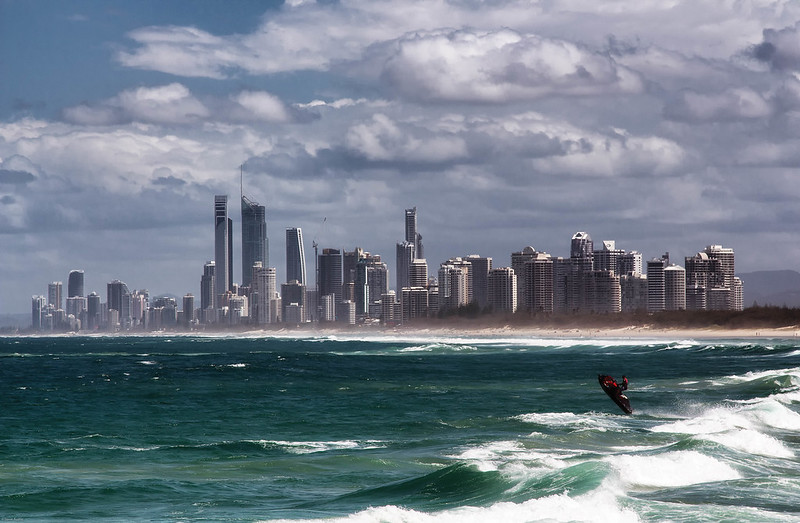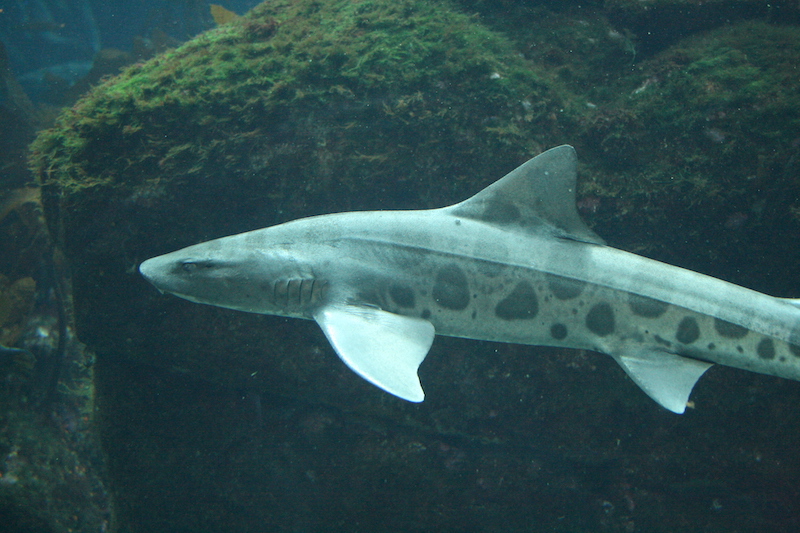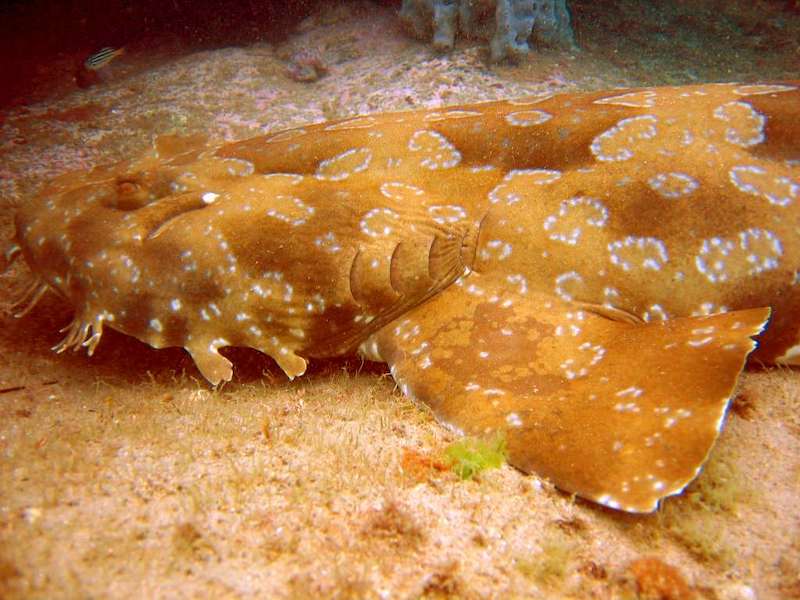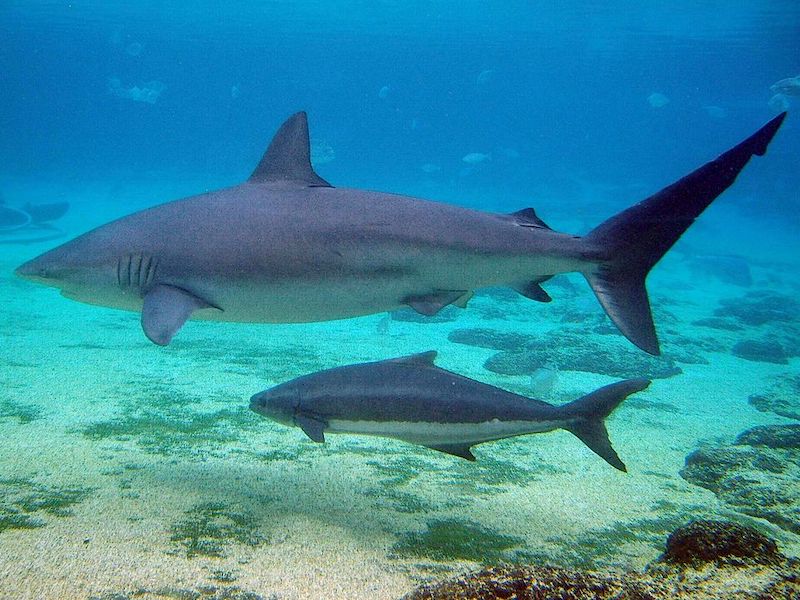The Gold Coast in Queensland, Australia is one of the world’s iconic vacation destinations.
It’s an excellent choice for a summertime getaway — especially to escape some of the Northern Hemisphere’s icy winters!
If you’ve come this far, you already know that the Gold Coast is well-known for its ocean recreation, from beautiful beaches to unbeatable surf breaks. The Gold Coast is also home to plenty of shopping, dining, and nightlife, as well as theme parks that attract vacationers and families alike.
But if you’re planning on getting in the water here, you might have one big question:
Does the Gold Coast have sharks? Is it safe to swim, surf, and dive at the Gold Coast in Australia?

Shark encounters at the Gold Coast and its waterways are rare considering authorities take precautions (like nets) to keep sharks away from shore. However, some of the sharks that do inhabit the waters of the Gold Coast are:
- Leopard sharks
- Carpet sharks
- Whaler sharks
- Bull sharks
- Great white sharks
Shark attacks at the Gold Coast are exceedingly rare — records indicate only 1 unprovoked attack every couple of years, and only 2 fatal attacks in the last 20 years. Gold Coast’s lakes and canals seem to be more dangerous than most of the main beaches, but still, shark attacks here are uncommon to say the least.
Let’s take a closer look at the types of sharks that live near Queensland, AU, photos, shark attack history and statistics, and more.
Types of Sharks at the Gold Coast, Australia
Australia’s east coast is home to an abundance of marine life, with some of the greatest biodiversity on the planet.
Ranging from its iconic coral reefs to fish and large mammals, there’s a little bit of everything here, including sharks.
The Gold Coast sees a large variety of shark species, with nearly 50 known shark species that work their way through the area.
While dangerous shark encounters are rare, you could still have a chance to see a shark while visiting the East Coast.
There are a number of harmless species that pop up frequently, as well as several larger and more dangerous species that are seen every once in a while, but more often remain elusive.
Leopard sharks

Leopard sharks are some of the most easily recognizable species of shark, in many places around the globe!
They take their name from their appearance, with light bodies and dark spots that resemble those of a leopard.
These sharks are relatively slow swimmers and average around 7 feet in length.
They’re not considered dangerous to humans, as they’re not an aggressive species.
Leopard sharks are one of the many species that are easily and frequently spotted by scuba divers in Queensland waters along the East Coast.
Wobbegong (Carpet) Sharks

These funky sharks, commonly known as carpet sharks, are thought to be one of Australia’s endemic shark species.
They are fairly large shark that hangs out near the bottom of shallow water, averaging just over 3 feet in length with a flat, blotchy-colored body and skin flaps around its snout. Its coloring ranges from sandy and brownish to a bright rust color.
Similar to leopard sharks, wobbegongs are a popular sight among divers along Australia’s East Coast.
There are a few different species of wobbegong, including the spotted wobbegong, banded wobbegong, and banded carpet sharks.
Whaler Sharks

Dusky whaler sharks are some of the “normal-looking” sharks found in the area.
They also have one of the wider distributions — these lengthy gray sharks with narrow, streamlined bodies are found extensively throughout Australia’s coastal waters, including along the Gold Coast.
Whaler sharks spend most of their time in deeper water along continental shelves, and are found at depths up to 400 meters.
These pointy-snouted sharks are predators for fish and even other sharks, and while they do inherently pose a danger to people, very few dangerous whaler shark encounters have been recorded.
Bull Sharks

Species of bull sharks are found all over the globe, and, unfortunately, it’s considered one of the most dangerous species of sharks no matter where you are.
Some experts even say it takes the top spot over both tiger sharks and great white sharks, due to its particularly aggressive behavior.
In the Gold Coast, bull sharks are the most dangerous and aggressive shark found somewhat commonly in these waters. They have a very large bite pressure and can be easily provoked.
Plus, their habitat overlaps with that of humans more than other large sharks’, which can lead to higher numbers of encounters and bites.
Great White Sharks

Great white sharks are some of the world’s most apex predators.
Also one of the world’s largest predators, they can range in size from 11 to nearly 20 feet in length, with white bellies and dark gray fins and the classic pointed snout.
Great whites roam the continental shelf waters around Australia, and have been responsible for shark bites.
While great whites are large and predatorial creatures, they are not necessarily more dangerous to humans than other sharks.
This is primarily because great white sharks are very elusive and behaviorally shy — it’s extremely difficult to try to encounter one naturally, even as a professional, and even more unlikely that they will voluntarily approach humans in any setting.
Encounters with great whites most often result from being in an area with a high volume of their food or other bait.
(Worried about jellyfish in Gold Coast? Read more here.)
History of Shark Attacks in the Gold Coast & Queensland
Any ocean coastline in the world will run the risk of putting people in close contact with marine animals, including sharks.
And sharks often get a bad reputation as dangerous animals, simply because of where they fall on the natural food chain.
Sharks are predators, yes, but humans are not their food! In fact, research shows that humans don’t even taste good to sharks, and it’s believed that the majority of shark bites across the globe result from mistaken identity — that is, a shark mistaking a person for its actual food, like a seal.
Most shark bites are isolated events, with a shark taking one nibble before realizing its mistake, and simply letting go. Some shark species can be combative, and will bite out of self-defense when provoked.
And speaking of food chains, while sharks are a dominant predator, they actually experience much more risk from us than we do from them.
Many shark species have suffered from overfishing, with some being hunted to near extinction which are now protected species in many areas of the world, like the gentle giant hammerhead sharks (three separate hammerhead species are protected).
Of course, there is the occasional dangerous or life-threatening shark attack. Queensland and the Gold Coast have seen two fatal shark attacks in the last 20 years, with extensive records tracking every shark encounter.
The region takes many precautions to prevent encounters, with nets and hooks designed to keep sharks away from shore — this means that while you’re extremely unlikely to even sight a shark while near the shore, if you do venture out farther to swim or surf, you increase the chances of coming across a shark.
It’s still important to hold those numbers in the right context, though.
Statistically, the chances of a shark attack are 1 in nearly 4 million, and any evidence of increasing shark attacks in recent years is actually a result of an increasing human population, and the equivalent increase in beachgoers, swimmers, and surfers.
Avoiding Gold Coast Shark Attacks (Tips & Things to Know)
While you’re just as unlikely to encounter a dangerous shark in Gold Coast as most other places in the world, it can still happen.
The East Coast of Australia sees nearly 50 species of sharks — most of them are not considered dangerous to humans, and most of those that are tend to stay far away from people in the first place.
However, these waters are still shark habitat, so it’s important to stay aware of your surroundings.
Whether you’re vacationing along Australia’s iconic beaches or at any other beach getaway, there are several things you can do to stay smart while swimming, surfing, scuba diving, or simply spending time in the water.
- Don’t isolate yourself, and stay close to shore. Most sharks are extremely unlikely to approach a group of people, so swim with friends if you can. It’s also good practice to stay relatively close to shore, which both puts separation between you and any lurking sharks and puts you closer to help if something does happen.
- Don’t swim during sharks’ active time. Sharks are most active at dawn and at dusk, and simply being in the water at these times increases your chances of coming close to one — though it’s still unlikely to be aggressive. This also applies to the lakes and canals throughout the region.
- Take care with accessories and clothing. You’d be surprised at the number of things — jewelry, swim suits, and other clothing — that can resemble other marine animals. Importantly, shiny things like jewelry or embellishments can mimic the appearance of fish scales when hit with the right light, and a shark looking for food can easily mistake you for its dinner.
- Don’t act like prey. Similar to the last point, our own behavior can also mimic that of sharks’ prey. Particularly, excessive splashing can draw the attention of sharks and mimic the swimming and trashing movements of seals.
When it comes to the Gold Coast in particular, avoid swimming in the lakes and canals if possible — they are a relative hotspot for bull shark activity and the site of many of the recorded attacks.
Wrapping Up
As with any other coastal destination, the Gold Coast is home to sharks.
However, this isn’t a reason for concern.
Sharks everywhere get more negative attention than they deserve — sharks aren’t usually interested in humans unless provoked, and many of them can be fascinating to observe.
Most of the time, humans are a much greater threat to sharks than they are to us, and a vacation in Gold Coast is unlikely to be spoiled by a shark encounter. Instead, sit back, relax, and enjoy this iconic Australian getaway!
For more guides, check out:
- Where do most shark attacks happen?
- Sharks in the Whitsunday Islands
- Sharks in Kauai, HI
- Sharks in Waikiki
Hope this helps!